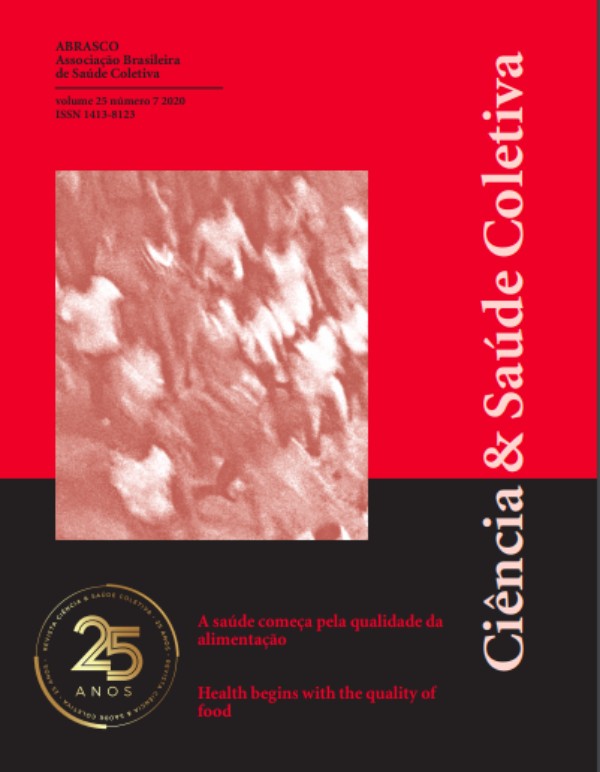0497/2018 - Insegurança Alimentar em famílias de área rural do extremo sul do Brasil.
Food Insecurity in rural families in the extreme south of Brazil.
Autor:
• Nathalia Matties Maas - Maas, N.M - <nathalia_maas@yahoo.com.br>ORCID: https://orcid.org/0000-0001-6949-8351
Coautor(es):
• Raul Andres Mendoza Sassi - Mendoza, R.A.M - <ramsassi@gmail.com>ORCID: https://orcid.org/0000-0002-4641-9056
• Rodrigo Dalke Meucci - Meucci, Rodrigo Dalke - <rodrigodalke@gmail.com>
ORCID: https://orcid.org/0000-0002-8941-3850
• Juraci Cesar - Cesar, J - <juraci.a.cesar@gmail.com>
ORCID: https://orcid.org/0000-0003-0864-0486
Resumo:
O estudo objetivou rastrear a prevalência de Insegurança Alimentar (IA) e estudar fatores associados em domicílios com crianças, mulheres e idosos na área rural do município de Rio Grande, RS em 2017. Foi um estudo transversal com amostragem sistemática de 80% dos domicílios permanentemente habitados. Utilizou-se uma versão reduzida da Escala Brasileira de Insegurança Alimentar (EBIA). Os fatores associados contemplaram dados referentes ao chefe da família, além de dados referentes ao domicílio. Prevalências e Razões de Prevalências e seus respectivos Intervalos de Confiança foram calculadas para a IA por meio da Regressão de Poisson com variância robusta. Dos 1.627 domicílios entrevistados, 26% (IC95% 23% - 28%) se encontraram em situação de IA, sendo maior (44%) naqueles domicílios que continham as três populações. Os domicílios mais atingidos foram os que o chefe da família tinha menor escolaridade, maior número de moradores, sem criação de animais, pertencentes ao menor quartil de renda e que recebiam Bolsa Família. Esse estudo mostrou a importância e a dimensão do problema da IA na região rural de Rio Grande, já que o conhecimento da real prevalência de IA nessa região é desconhecido.Palavras-chave:
Segurança Alimentar e Nutricional, Prevalência, População Rural, Fatores de Risco.Abstract:
The objective of the study was to track the prevalence of Food Insecurity (FI) and to study associated factors in households with children, women and the elderly in the rural area of the city of Rio Grande, RS. It was a cross-sectional population-based study, with systematic sampling to 80% of permanently inhabited households. A reduced version of the Brazilian Scale of Food Insecurity was used. The associated factors included data referring to the head of the family, as well as data referring to the household. Prevalences and prevalence ratios and their respective Confidence Intervals were calculated for Food Insecurity through Poisson Regression with robust variance. Of the 1,627 domiciles interviewed, 26% (CI95% 23% - 28%) were in an FI situation, being greater (44%) in those households that contained the three populations. The most affected those in whom the head of the family had less than four years of schooling, with more residents, without raising of animals for sale or family consumption, belonging to the lowest income quartile and receiving benefitsthe Bolsa Família Program. Already the least affected were those households the household chief was 70 or more. The present study showed the importance and the dimension of the FI problem in the rural region of Rio Grande, since the actual FI prevalence of this region is not known.Keywords:
Food and Nutrition Security, Prevalence, Rural Population, Risk Factors.Conteúdo:
Acessar Revista no ScieloOutros idiomas:
Food Insecurity in rural families in the extreme south of Brazil.
Resumo (abstract):
The objective of the study was to track the prevalence of Food Insecurity (FI) and to study associated factors in households with children, women and the elderly in the rural area of the city of Rio Grande, RS. It was a cross-sectional population-based study, with systematic sampling to 80% of permanently inhabited households. A reduced version of the Brazilian Scale of Food Insecurity was used. The associated factors included data referring to the head of the family, as well as data referring to the household. Prevalences and prevalence ratios and their respective Confidence Intervals were calculated for Food Insecurity through Poisson Regression with robust variance. Of the 1,627 domiciles interviewed, 26% (CI95% 23% - 28%) were in an FI situation, being greater (44%) in those households that contained the three populations. The most affected those in whom the head of the family had less than four years of schooling, with more residents, without raising of animals for sale or family consumption, belonging to the lowest income quartile and receiving benefitsthe Bolsa Família Program. Already the least affected were those households the household chief was 70 or more. The present study showed the importance and the dimension of the FI problem in the rural region of Rio Grande, since the actual FI prevalence of this region is not known.Palavras-chave (keywords):
Food and Nutrition Security, Prevalence, Rural Population, Risk Factors.Ler versão inglês (english version)
Conteúdo (article):
FOOD INSECURITY IN RURAL FAMILIES IN THE EXTREME SOUTH OF BRAZIL.Autores:
Nathalia Matties Maas. Maas, N.M. Universidade Federal do Rio Grande. Faculdade de Medicina. Programa de Pós-Graduação em Saúde Pública. nathalia_maas@yahoo.com.br
Raúl Andres Mendoza-Sassi. Mendoza-Sassi, R.A. Universidade Federal do Rio Grande, Faculdade de Medicina. ramsassi@gmail.com
Rodrigo Dalke Meucci. Meucci, R.D. Universidade Federal do Rio Grande, Faculdade de Medicina.
rodrigodalke@gmail.com
Juraci Almeida Cesar. Cesar, J.A. Universidade Federal do Rio Grande, Faculdade de Medicina.
juraci.a.cesar@gmail.com
RESUMO
O estudo objetivou rastrear a prevalência de Insegurança Alimentar (IA) e estudar fatores associados em domicílios com crianças, mulheres e idosos na área rural do município de Rio Grande, RS em 2017. Foi um estudo transversal com amostragem sistemática de 80% dos domicílios permanentemente habitados. Utilizou-se uma versão reduzida da Escala Brasileira de Insegurança Alimentar (EBIA). Os fatores associados contemplaram dados referentes ao chefe da família, além de dados referentes ao domicílio. Prevalências e Razões de Prevalências e seus respectivos Intervalos de Confiança foram calculadas para a IA por meio da Regressão de Poisson com variância robusta. Dos 1.627 domicílios entrevistados, 26% (IC95% 23% - 28%) se encontraram em situação de IA, sendo maior (44%) naqueles domicílios que continham as três populações. Os domicílios mais atingidos foram os que o chefe da família tinha menor escolaridade, maior número de moradores, sem criação de animais, pertencentes ao menor quartil de renda e que recebiam Bolsa Família. Esse estudo mostrou a importância e a dimensão do problema da IA na região rural de Rio Grande, já que o conhecimento da real prevalência de IA nessa região é desconhecido.
Palavras chave: Segurança Alimentar e Nutricional, Prevalência, População Rural, Fatores de Risco.
ABSTRACT
This study aimed to track the prevalence of Food Insecurity (FI) and to study associated factors in households with children, women and older adults in the rural area of the city of Rio Grande, RS. This is a cross-sectional population-based study, with systematic sampling of 80% of permanently inhabited households. A short version of the Brazilian Scale of Food Insecurity (EBIA) was employed. The associated factors included data referring to the head of the household, as well as data referring to the household. The levels of prevalence and prevalence ratios and their respective confidence intervals were calculated for food insecurity through Poisson regression with robust variance. Of the 1,627 domiciles interviewed, 26% (95% CI, 23%-28%) were in an FI situation, and households that included three populations were higher (44%). The most affected domiciles were those in which the head of the household had less than four years of schooling, with more residents, without animal husbandry, belonging to the lowest income quartile and receiving family grants (“Bolsa Família” Program). This study showed the relevance and magnitude of the FI problem in the rural region of Rio Grande since knowledge about the actual FI prevalence of this region is unknown.
Keywords: Food and Nutrition Security, Prevalence, Rural Population, Risk Factors.
INTRODUCTION
Food and Nutrition Security is defined as the universal right to regular and permanent access to quality and sufficient food, without compromising access to other essential needs. It should be based on food practices that promote health and respect cultural diversity in an environmentally and socially sustainable way. The unavailability of food, lower purchasing power or inadequate use at the household level is the characterization of Food and Nutritional Insecurity1,2.
It is known that Food Insecurity (FI) affected 35.3% of private rural households in 2013 in Brazil. The different prevalence levels between the regions emphasize the regional inequality, more perceived in the North (41.4%) and Northeast (50.1%) regions, where the prevalence is twice as low3. In Rio Grande do Sul, the National Household Sample Survey (PNAD) data for 2009 and 2013 show prevalence rates for rural regions of 14.2% and 15.3%, respectively3. In areas not covered by the PNAD, such as rural areas of small and medium-sized municipalities, the prevalence of FI is unknown, and in these municipalities, the concentration of poverty may be higher4.
Besides the higher concentration of poverty, food access is difficult in these areas. One of the reasons would be the shift from farming activities to non-farming activities, due to the crisis in agriculture and mechanization of production, which transformed rural areas into areas with typically urban traits, where the population is not dependent on income from agricultural activities5. Another reason is rural dwellers’ difficulty in transportation to access goods and services and some specific food goods due to lower income concentration6,7.
In Brazil, in 2015, the economic crisis caused an increase of 4.1 million people living in poverty, of which 1.4 million are in extreme poverty8. Thus, Brazil’s exit from the hunger map, observed in 2014, may be reversed due to economic aspects that affect the Food Security (FS) of the population9. The lack of food in sufficient quantity and quality is a significant problem for families who were already in an FI situation before 2015 and for those who later entered the situation8. It is also known that the most severe damage of FI occurs primarily in children, women and the elderly, which are vulnerable groups10.
In children, this inadequate consumption of food from the qualitative and quantitative point of view and the low household income are factors related to growth and development deficit11,12. Besides socioeconomic disadvantage at work, food deprivation is the main reason for vulnerability in women. Women prioritize their children or husbands, and they are restricted to a level of hunger and malnutrition, thus causing FI13,14. In the older adults, the psychological, social, economic factors and the aging process explain this increased susceptibility to FI15.
Thus, this study aimed to track the prevalence of FI in the rural area of a medium-sized municipality in the extreme south of Brazil, among households with children up to five years of age, women of childbearing age and older adults, and to identify risk factors to increase knowledge about FI distribution in this type of municipality and population.
METHODS
The cross-sectional, population-based study was conducted in the rural area of the municipality of Rio Grande (RS), located in the extreme south of Brazil, 250 km from the border with Uruguay and about 300 km from the state capital, Porto Alegre. This study was part of a Research Consortium entitled “Health of Rio Grande’s rural population”, which aimed to determine the life and health conditions of children, women of childbearing age and older adults in the rural area of the municipality of Rio Grande (RS), Brazil. This municipality has an area of approximately 2,709 km², and its population was estimated at around 208,000 inhabitants in 2016, of which 4% live in the rural area, distributed in approximately 3,000 households and 24 census tracts.
The study population consisted of households with at least one of the three age groups: children up to five years of age, women of childbearing age (15 to 49 years) and older adults (over 60 years of age). If the household had at least one child older than five years, the mother was also interviewed, as responsible for the child. Only households with heads of household who were 18 years or older were included.
The sample size was calculated in the EpiInfo version 7.0 program using an estimated prevalence of Food Insecurity in this population of 35%, 95% confidence level, and error of three percentage points for more or less, and a 10% was added to this amount for possible losses and refusals, resulting in 1,067 households. A statistical power of 80% was used to calculate the risk factors, with a 95% confidence level, a Relative Risk of 1.7 was considered, as well as a 2-to-1 ratio of non-exposed (household income > 1 minimum wage) with exposed (household income ≤ 1 minimum wage), and prevalence of FI in unexposed of 18%. This amount was grossed up by 10% to cater for losses and refusals, and 20% for confounding factor, resulting in 1,133 households.
Systematic random sampling was performed in permanently inhabited households in the rural area of Rio Grande, where four out of five households were selected to comprise 80% of each population (women aged 15-49 and older). Then, a number from one to five was drawn in each census tract, which corresponded to the skip. Regarding the sampling of children under five years of age, a census of households was conducted. Thus, the households skipped for the sampling of women between 15 and 49 years old and older adults were approached to verify whether there were residents under five years of age. In this case, the skip was annulled and the mother was interviewed through the child’s and household’s questionnaires.
As a data collection instrument, a short version of the Brazilian Food Insecurity Scale (EBIA) proposed by Santos16 was used. This version contains five questions and detects FI in the household, with high sensitivity and specificity, 95.7% and 100% respectively, concerning the original scale16. In the affirmative answer of at least one issue of scale, the household was characterized as “Food Insecure”.
Data were collected from April to October 2017 by six previously trained interviewers. Tablets were used through the RedCap® program to collect data. Data collection quality control was performed through the application of a short version of the questionnaire, in 10% of the visited domiciles. The re-interviews were conducted through telephone calls by the master’s students of the consortium. The Kappa statistic for the household ranged from 0.52 to 0.94.
The independent variables used to analyze the associated factors were: head of the household (man, woman without partner, woman with partner), self-reported skin color (white, black/brown), age categorized in full years (18-29 years, 30-39 years, 40-59 years, 60 to 69 years and 70 years or more), number of residents in the household (1, 2, 3, 4, 5 or more), quartiles of household income (classified from the lower quartile mean to the highest quartile mean), schooling (< 4 years, 4-11 years, 12 or more years), receiving the Family Grant (“Bolsa Família”) (no, yes), animal husbandry (no, yes) and food growing/cultivation (no, yes).
Data were analyzed in the Stata program, version 14.1 (Stata Corp., College Station, USA). The analysis was initially descriptive, where the percentages of the categories of each independent variable were calculated. In the case of food insecurity, the general prevalence and its 95% confidence interval (95% CI) were calculated. Subsequently, the factors associated with Food Insecurity were analyzed through Poisson regression with a robust estimation of the variance, obtaining crude and adjusted PR and their respective 95% CI. The choice of the Poisson regression for this analysis instead of the logistic regression built on the understanding that its use is more appropriate in cross-sectional studies whose prevalence of the outcome is high17.
The multivariate analysis followed a three-level hierarchical analysis model17. The first level included the sociodemographic variables, the second contained the variables on food cultivation and animal husbandry, and the third level, household income and receipt of a family grant. Then, the variables of each level were adjusted to each other, using backward regression. Those with p<0.20 were maintained to be adjusted with the variables of the next level to avoid positive confounding. A p-value of p<0.05 from a two-tailed test was adopted in all statistical tests.
The research was approved by the Health Research Ethics Committee of the Federal University of Rio Grande, according to Resolution Nº 466/12, and the informed consent was obtained from all the respondents.
RESULTS
In the household approach in the rural area of Rio Grande, RS, 1,785 households were eligible for the study, of which 1,627 had the head of the household interviewed (8.9% of losses). Of the households sampled, 35.7% had only women of childbearing age, 40.6% had only older adults, 17.6% had children under the age of 5 and women of childbearing age, 5.0% had women of childbearing age and older adults, and 1.1% had all three population groups. There were no households with only children, or with both children and older adults.
Table 1 shows the distribution of households concerning socioeconomic and demographic variables. We can observe a predominance of households with female heads of the household living with a partner (54.4%), white (88.3%), with 4-11 years of schooling (49.4%), which do not grow food and do not practice animal husbandry (69.8% and 60.1%, respectively). Also, one in ten households had residents enrolled in the Bolsa Família Program (10.7%).
The Food Insecurity situation was 26% (95% CI 23%-28%). The FI prevalence varied significantly (p<0.001) per population groups existing in the households. The highest prevalence was observed in the households with the three groups (children under five, women of childbearing age and older adults), reaching 44%. In households with only women of childbearing age, FI was 32%; and in households with children and women of childbearing age, and households with women and older adults, FI was 29%. The lowest prevalence of FI was observed in households with only older adults (18%).
Table 1 also shows the prevalence of FI according to the characteristics of the families. Except for the variable skin color of the head of the household, all other differences were significant. The highest prevalence is observed in households where women are the head of the household and live with their partner (30.7%), and are aged 40-59 years (35.8%). FI was 1.5 times more likely in households with more than five residents compared to those in which only one person lived, and increased progressively with declining income quartiles (37.6% in the poorest vs. 15% in the richest). Also, FI was also higher in households with no animal husbandry and food growing. FI was twice as large in households where the head of the household was a beneficiary of cash benefits programs (Bolsa Família).
Table 2 shows the crude and adjusted PR. We can observe that, after adjustment, households with heads of household aged 70 years or older (PR 0.63), with less than 4 years of schooling (PR 2.14), households with five or more residents (PR 1.73), with animal husbandry for sale or consumption (PR 0.83) and who were beneficiaries of the Bolsa Família program (RP 1.52) remained significantly associated with FI. There was a significant linear trend (inverse association) between FI and household income and was almost 1.5 times more likely in the lowest income quartile compared with the highest income quartile.
DISCUSSION
In this study, FI reached more than a quarter of rural households, and we could identify households with a higher risk of this outcome, evidenced by low socioeconomic and educational levels, low participation in cash benefits programs, a higher number of residents in the household and lack of subsistence agriculture. Although the prevalence of FI observed in this study is lower than that found in other Brazilian studies, most of them were performed in the northeast region. These surveys were carried out in several municipalities in the Northeast in different years and found prevalence levels ranging from 52.1% to 88.5%10,19-22, which may be due to socioeconomic gaps between regions.
The PNAD brings prevalence of FI to the rural regions of the country in 2009 and 2013, of 35.2% and 35.3%, respectively. When analyzed by regions, the South has lower indices than the other states, 14.2% in 2009 and 15.3% in 20133, and are, thus, lower than those found in this study. The difference with FI found in this study can be explained by the fact that the sample design of the PNAD does not include municipalities such as the region that is the object of this research4,8. Another aspect that may explain this gap in the prevalence is that this present study included households with specific groups (children up to five years of age, women of childbearing age and older adults), who may be more predisposed to FI, while the PNAD included all households, regardless of age groups.
When FI was analyzed by the presence of the population groups, the households that had children, women and older adults had an increased FI prevalence (44%). These groups are considered to be vulnerable to FI10 since they feel the first effects of restricting food in both quality and quantity. Also, as per Hoffmann2, the presence of children under 18 and the number of residents make these households more susceptible to FI.
Two hypotheses are brought about regarding the higher prevalence of FI in households where women live with a partner: first, only one resident or partner works, and in this case there is a lower per capita income; the second, the woman self-declares as head of the household, since the partner is possibly unemployed and the income per capita is also reduced. However, there are no elements in this research or other studies that can prove any of these possibilities.
Regarding age, FI was lower in the age group of 70 years or more, even when adjusted for other factors, something that can be explained by the receipt of pensions that complement the household income19.
The variables that underpin the socioeconomic level (number of residents at home, household income and schooling) make up an FI severity triad and are strong risk factors10, and all three were found in this study.
The FI increased progressively with the number of residents in the household, even with a linear trend, and was consistent with other studies conducted in rural areas6,10,19,23-25. This finding shows that family size is not necessarily accompanied by a higher household income. Large families have higher food and consumer goods expenditure but not all household members have an income6.
Schooling is another FI-related socioeconomic factor10,19,26-28. It was significantly associated with the outcome in both crude and adjusted analysis, with the risk of higher FI is found in households where the head had less than four years of schooling.
The analysis also showed the existence of a linear trend, in the association between FI and income quartiles, and the households of the lower quartile were much more likely to show FI than households of the highest quartile. These data are consistent with the literature6,10,19-21,24. According to Hoffman2, household income is the variable with the highest impact when it comes to FI. In recent years, the economic crisis in Brazil has increased the number of individuals living in poverty and extreme poverty in the country, causing more individuals to exceed the poverty line, consequently increasing the social vulnerability of households and the risk of FI8.
Regarding food growing or cultivation and animal husbandry, only animal husbandry for sale or family consumption remained associated in the adjusted analysis. Studies show that these means of production used for household consumption, exchange between families, sharing or selling support a better diet in these households, increasing FS6,28,29. The lack of association between food growing and FI may be due to a limitation of the study of adequately quantifying the agricultural production goods among the households studied.
Regarding the large proportion of households with no food cultivation and animal husbandry, the rural area of Rio Grande has some aspects that do not favor the practice of these activities or other type of activity, such as, for example, fishing is predominant in the islands sectors. There is also a vast extension of sandy land, not favoring agriculture or livestock. On the other hand, sectors close to the urban area have an urban structure.
Households with Bolsa Família program beneficiaries were 52% more likely to be at risk of FI after adjustment. In this context, both the PNAD and the National Survey on Demography and Health of Children and Women (PNDS) show an increased prevalence of FI in these households in recent years23,30, which is a significant concern, if indeed cash benefits programs are insufficient to change the context of households within the lower income stratum. Also, it is necessary to take into account the low coverage (only 10.7%) of the Bolsa Família Program in the rural region of Rio Grande.
Studies indicate that the receipt of this benefit contributes to the income supplementation of vulnerable households and facilitates access to food, especially in the promotion of FS21,31,32. However, another study states that the program alone is not enough to ensure an FS28 condition, which is linked to a more complex socio-economic situation. Because this is a cross-sectional study, the prevalence of FI in these households before the implementation of the program is unknown, and the prevalence of FI may have been higher in this case.
One of the limitations of this study is its cross-sectional design, which hinders the inference of causality about the associations, as is the case of the analysis between the receipt of Bolsa Família and FI, thus resulting in reverse causality. However, it is possible to establish associations and identify groups most affected by the outcome. Another limitation is the recall bias, but it has been minimized by the short time bracket of the short EBIA scale, which refers to the last 3 months, as well as the full version of EBIA.
The scale used in this study was a short version of the EBIA16, which was proposed to reduce the study’s time and cost. The short scale had not yet been used in any rural region, only in urban areas, where it detected FI and FS with high sensitivity and specificity, 95.7% and 100%, respectively16, compared to the original scale. This short scale was employed because the study was included in a research consortium, with a pre-established limit of questions for each researcher. The main limitation of this scale is that it does not detect the levels of severity of FI (mild, moderate or severe) as the original scale does, hampering the detection of FI’s most severe case, where there is a quantitative reduction of food among children, disruption of family dietary patterns or hunger3.
It can be observed that the FI in the rural population of Rio Grande is considerable since a little more than a quarter of the household of the rural area of the municipality are in this situation. A higher prevalence was observed in the households with the three groups, reaching 44%. Among them, the most affected are the residents of households with the worst socioeconomic indices. Also, being a rural resident is associated with increased food insecurity, regardless of subsistence farming.
Support networks between communities and households and ways of sharing food, such as fairs and exchanges, can be ways to improve families’ access to sufficient quantity and quality of food. Given that the rural area is a favorable environment for food production, this activity should be encouraged through public policies to encourage agricultural production.
REFERENCES
1. BRASIL. Lei no 11.346, de 15 de setembro de 2006. Cria o Sistema Nacional de Segurança Alimentar e Nutricional - SISAN com vistas em assegurar o direito humano à alimentação adequada e dá outras providências. Diário Oficial [da] República Federativa do Brasil, Brasília, DF, 18 set. 2006.
2. Hoffmann R. Pobreza, Insegurança Alimentar e desnutrição no Brasil. Estud Av. Vol 9. Nº 24. São Paulo, 1995.
3. Brasil. Ministério do Planejamento, Orçamento, e Gestão. Ministério do desenvolvimento social e combate à fome. Instituto Brasileiro de Geografia e Estatística - IBGE. Pesquisa Nacional por Amostra de Domicílios – PNAD 2013. Segurança Alimentar, Brasil, Rio de Janeiro: IBGE, 2014.
4. Instituto Brasileiro de geografia e Estatística, IBGE 2010. Indicadores sociais municipais: uma análise dos resultados do universo do censo demográfico 2010 / IBGE, Coordenação de População e Indicadores Sociais. Available from: https://censo2010.ibge.gov.br/noticiascenso.html?busca=1&id=3&idnoticia=2019&t=indicadores-sociais-municipais-2010-incidencia-pobreza-maior-municipios-portemedio&view=noticia. Access on 13/02/2018.
5. Baldasi OV. Mudanças no meio rural e desafios para o desenvolvimento sustentável. São Paulo Perspec. 2001; 15 (1): 155-165.
6. Silva EPK, Medeiros DS, Martins PC, Souza LA, Lima GP, Rêgo MAS, Silva, TO, Freire AS, Silva FM. Insegurança Alimentar em comunidades rurais no Nordeste brasileiro: Faz diferença ser quilombola? Cadernos de Saúde Pública. 2017; 33(4):e00005716: 1-14.
7. Barbosa ALNH, Menezes TA e Andrade BC. Demanda por produtos alimentares nas areas rurais e urbanas do Brasil. Pesquisa e Planejamento Econômico, PPE. 2014; 44(3): 507-544.
8. Instituto de pesquisa econômica aplicada. IPEA. Boletim de políticas sociais: acompanhamento e análise, nº 23, 2015. Available from: http://www.ipea.gov.br/portal/index.php?option=com_content&view=article&id=25812&Itemid=9. Access on 13/02/2018.
9. FAO - Food and Agriculture Organization of the United Nations. Brasil em resumo. Available from: http://www.fao.org/brasil/fao-no-brasil/brasil-em-resumo/en/. Access on 20/03/2018.
10. Aires JS, Martins MC, Joventino ES, Ximenes LB. (In)Segurança alimentar em famílias de pré escolares de uma zona rural do Ceará. Acta Paul Enferm 2012; 25 (1): 102-108.
11. Carneiro LBV. Associação entre Insegurança Alimentar e deficiências de micronutrientes em crianças assistidas pelo SUS no município do Rio de Janeiro. [Dissertação de Mestrado]. Rio de Janeiro. Escola Nacional de Saúde Pública Sergio Arouca. 2015.
12. Sperandio N e Priore SE. Prevalência de insegurança alimentar domiciliar e fatores associados em famílias com pré-escolares, beneficiários do Programa Bolsa Família em Viçosa, Minas Gerais, Brasil. Epidemiol. Serv. Saúde. 2015; 24(4): 739-748.
13. Siliprandi E. Políticas de Segurança Alimentar e Relações de Gênero. Cadernos de Debate UNICAMP. 2004; 5(11): 38-57.
14. Ivers LC and Cullen KA. Food Insecurity: special considerations for women. The American Journal of Clinical Nutrition. 2011; 94: 1740-1744.
15. Lu JS and Frongillo EA Jr. Nutritional and health consequences are associated with food assistance programmes over time in the elderly. Public Health Nutri. 2009; 12(11): 2113-2119.
16. Santos LP, Lindemann IL, Motta JVS, Mintem G, Bender E, Gigante DP. Proposta de versão curta da Escala Brasileira de Insegurança Alimentar. Rev Saúde Pública. 2014; 48 (5): 783-789.
17. Barros AJ and HirakataVN. Alternatives for logistic regression in cross-sectional studies: an empirical comparison of models that directly estimate the prevalence ratio. BMC Med. Res. Methodol. 2003; 20(3): 21.
17. Victora CG, Huttly SR, Fuchs SC, Olinto, MTA. The role of conceptual frameworks in epidemiological analysis: a hierarchical approach. Int J Epidemiol. 1997; 26 (1): 224-227.
19. Rosa TEC, Mondini L, Gubert MB, Sato GS, Benício MAD. Segurança Alimentar em domicílios chefiados por idosos, Brasil. Rev Bras Geriatr Gerontol, Rio de Janeiro, 2012. 15 (1): 69-77.
20. Vianna RPDT, Segall-Corrêa, AM. Insegurança alimentar das famílias residentes em municípios do interior do estado da Paraíba, Brasil. Revista de Nutrição 2008; (8): 111s-122s.
21. Rocha EMB, Lima RT, Almeida PC. Insegurança alimentar relacionada à área de residência em município do Semiárido brasileiro. Cad Saúde Colet (Rio J.) 2014; (22) :205-211.
22. Oliveira JS, Lira PIC, Andrade SLLS, Sales AC, Maia SR, Filho MB. Insegurança Alimentar e estado nutricional de crianças em São Jõao do Tigre, no semi-árido do Nordeste. Rev Bras Epidemiol. 2009. 12 (3): 413-23.
23. Brasil. Ministério do Planejamento, Orçamento, e Gestão. Ministério do desenvolvimento social e combate a fome. Instituto Brasileiro de Geografia e Estatística. Pesquisa Nacional por Amostra de Domicílios – PNAD 2004 – 2009. Segurança alimentar, Brasil, Rio de Janeiro: IBGE, 2010.
24. Ihab An RA; Wan Manan WM, Wan Suriati WN, Zallilah MS, Rusli AM. Nutritional outcomes related to household food insecurity among mothers in rural. J Health Popul Nutr 2013; 31 (4): 480-489.
25. Pico Fonseca SM, Pachón H. Factores asociados con la seguridad alimentaria en un Municipio Rural del norte del Cauca, Colombia. Arch. latinoam. Nutr 2012; 62 (3): 227-233.
26. Regassa N, Stoecker BJ. Household food insecurity and hunger among households in Sidama district. Public Health Nutr 2012; 15 (7): 1276-1283.
27. Guerrero N, Walsh MC, Malecki KC, Nieto FJ. Urban-Rural and Regional variability in the Prevalence of Food Insecurity: the Survey of the Health of Wisconsin. WMJ, 2014. 113 (4): 133-138.
28. Tomayko EJ, Mosso KL, Cronin KA, Carmichael K, Kim K, Parker T, Yaroch AL, Adams AK. Household food insecurity and dietary patterns in rural and urban American Indian families with Young children. BMC Public Health. 2017; 17 (1): 611.
29. Ibase. Repercussões do Programa Bolsa Família na Segurança Alimentar e Nutricional das famílias beneficiadas. IBASE, Documento síntese. 2008.
30. Brasil. Ministério da Saúde. Centro Brasileiro de Análise e Planejamento. Pesquisa Nacional de Demografia e Saúde da Criança e da Mulher – PNDS 2006: dimensões do processo reprodutivo e da saúde da criança. Brasília, 2009. Série G. Estatística e Informação em Saúde. 300 p.
31. Segall-Corrêa AM, Marin-Leon L, Helito H, Pérez-Escamilla R, Santos LMP, Paes-Souza R. Transferência de renda e Segurança Alimentar no Brasil: análise dos dados nacionais. Rev. Nutr. Campinas 2008; (21): 39s-51s.
32. Cabral CS, Lopes AG, Lopes JM, Vianna RPT. Segurança alimentar, renda e Programa Bolsa Família: estudo de coorte em municípios do interior da Paraíba, Brasil, 2005-2011. Cad. Saúde Pública 2014; (30): 393-402.













